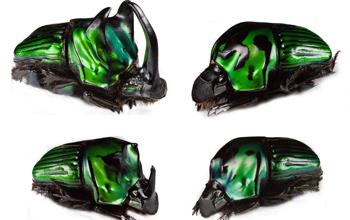Multimedia Gallery
Trimorphism in Dung Beetles (Image 2)
An illustration showing horn development in the male trimorphic beetle Oxysternon conspicillatum. Clockwise from top right: A female, a gamma male, a beta male and an alpha male. Both the alpha and beta males produce horns, but the relative size of the horn is larger in the alpha. The gamma male and female lack head horns entirely.
In a National Science Foundation (NSF)-supported study, University of New Mexico biology professor J. Mark Rowland and University of Montana professor Douglas J. Emlen studied the evolution of male dimorphism in insects and were surprised to find that many species of beetles are capable of producing not only two, but three different types of males.
The researchers found male trimorphism in dung beetles and in other families of beetles, as well as in other weapon systems--which include head horns in dung beetles, mandibles in stag beetles and ventral spines in weevils. The dung beetle has an alpha, beta and gamma (completely hornless) male--three qualitatively distinct forms. The researchers also found that in these trimorphic species, one of the three male forms was always female-like in morphology. The researchers believe these gamma males may use this as a tactical deception to evade combat and earn sexual encounters.
To learn more, see the UNM news story Sexual Encounters of the Third Kind: Darwin's Beetles Still Producing Surprises. [Research supported by NSF grant IOS 06-42409.] (Date of Image: 2008) [See related image Here.]
Credit: J. Mark Rowland/Douglas J. Emlen
See other images like this on your iPhone or iPad download NSF Science Zone on the Apple App Store.
Images and other media in the National Science Foundation Multimedia Gallery are available for use in print and electronic material by NSF employees, members of the media, university staff, teachers and the general public. All media in the gallery are intended for personal, educational and nonprofit/non-commercial use only.
Images credited to the National Science Foundation, a federal agency, are in the public domain. The images were created by employees of the United States Government as part of their official duties or prepared by contractors as "works for hire" for NSF. You may freely use NSF-credited images and, at your discretion, credit NSF with a "Courtesy: National Science Foundation" notation.
Additional information about general usage can be found in Conditions.
Also Available:
Download the high-resolution JPG version of the image. (2.4 MB)
Use your mouse to right-click (Mac users may need to Ctrl-click) the link above and choose the option that will save the file or target to your computer.

